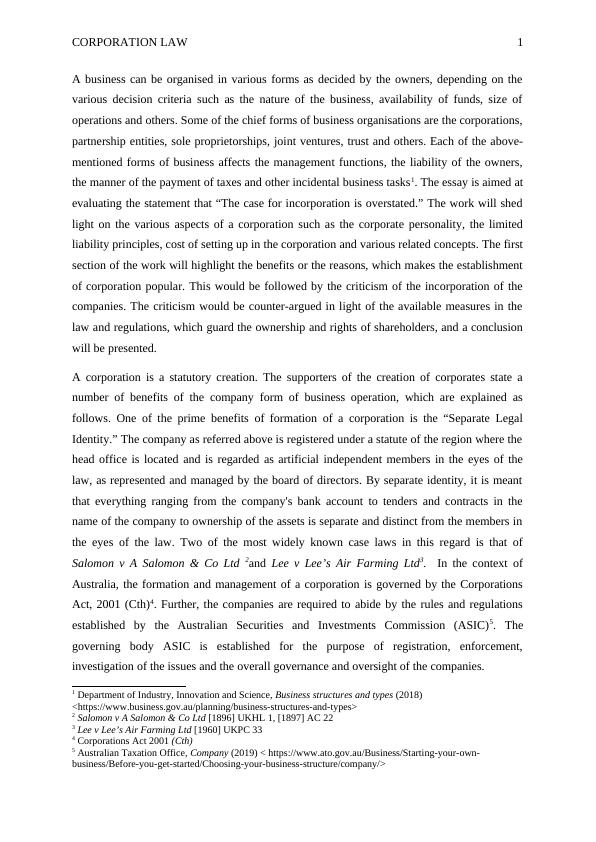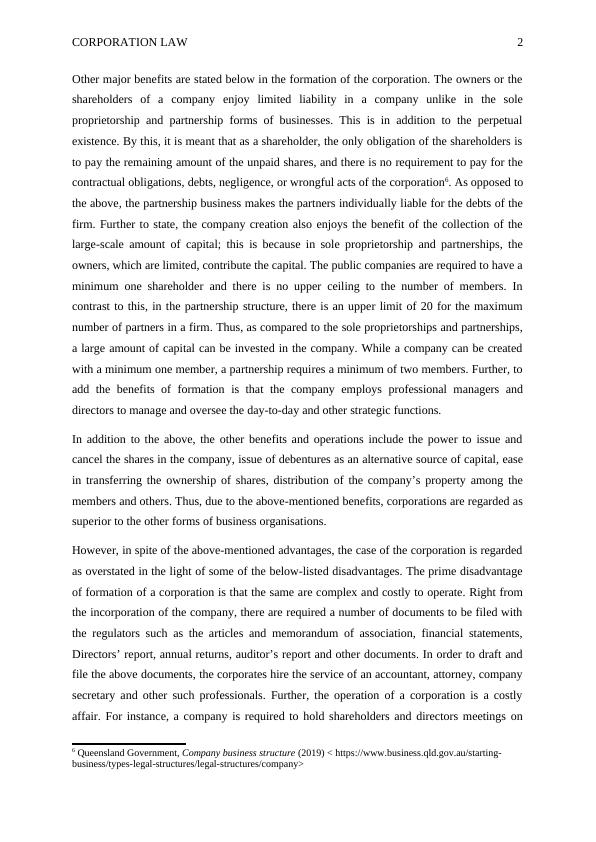The Case for Incorporation: Benefits and Criticisms
Added on 2023-01-17
8 Pages2680 Words71 Views
CORPORATION LAW

CORPORATION LAW 1
A business can be organised in various forms as decided by the owners, depending on the
various decision criteria such as the nature of the business, availability of funds, size of
operations and others. Some of the chief forms of business organisations are the corporations,
partnership entities, sole proprietorships, joint ventures, trust and others. Each of the above-
mentioned forms of business affects the management functions, the liability of the owners,
the manner of the payment of taxes and other incidental business tasks1. The essay is aimed at
evaluating the statement that “The case for incorporation is overstated.” The work will shed
light on the various aspects of a corporation such as the corporate personality, the limited
liability principles, cost of setting up in the corporation and various related concepts. The first
section of the work will highlight the benefits or the reasons, which makes the establishment
of corporation popular. This would be followed by the criticism of the incorporation of the
companies. The criticism would be counter-argued in light of the available measures in the
law and regulations, which guard the ownership and rights of shareholders, and a conclusion
will be presented.
A corporation is a statutory creation. The supporters of the creation of corporates state a
number of benefits of the company form of business operation, which are explained as
follows. One of the prime benefits of formation of a corporation is the “Separate Legal
Identity.” The company as referred above is registered under a statute of the region where the
head office is located and is regarded as artificial independent members in the eyes of the
law, as represented and managed by the board of directors. By separate identity, it is meant
that everything ranging from the company's bank account to tenders and contracts in the
name of the company to ownership of the assets is separate and distinct from the members in
the eyes of the law. Two of the most widely known case laws in this regard is that of
Salomon v A Salomon & Co Ltd 2and Lee v Lee’s Air Farming Ltd3. In the context of
Australia, the formation and management of a corporation is governed by the Corporations
Act, 2001 (Cth)4. Further, the companies are required to abide by the rules and regulations
established by the Australian Securities and Investments Commission (ASIC)5. The
governing body ASIC is established for the purpose of registration, enforcement,
investigation of the issues and the overall governance and oversight of the companies.
1 Department of Industry, Innovation and Science, Business structures and types (2018)
<https://www.business.gov.au/planning/business-structures-and-types>
2 Salomon v A Salomon & Co Ltd [1896] UKHL 1, [1897] AC 22
3 Lee v Lee’s Air Farming Ltd [1960] UKPC 33
4 Corporations Act 2001 (Cth)
5 Australian Taxation Office, Company (2019) < https://www.ato.gov.au/Business/Starting-your-own-
business/Before-you-get-started/Choosing-your-business-structure/company/>
A business can be organised in various forms as decided by the owners, depending on the
various decision criteria such as the nature of the business, availability of funds, size of
operations and others. Some of the chief forms of business organisations are the corporations,
partnership entities, sole proprietorships, joint ventures, trust and others. Each of the above-
mentioned forms of business affects the management functions, the liability of the owners,
the manner of the payment of taxes and other incidental business tasks1. The essay is aimed at
evaluating the statement that “The case for incorporation is overstated.” The work will shed
light on the various aspects of a corporation such as the corporate personality, the limited
liability principles, cost of setting up in the corporation and various related concepts. The first
section of the work will highlight the benefits or the reasons, which makes the establishment
of corporation popular. This would be followed by the criticism of the incorporation of the
companies. The criticism would be counter-argued in light of the available measures in the
law and regulations, which guard the ownership and rights of shareholders, and a conclusion
will be presented.
A corporation is a statutory creation. The supporters of the creation of corporates state a
number of benefits of the company form of business operation, which are explained as
follows. One of the prime benefits of formation of a corporation is the “Separate Legal
Identity.” The company as referred above is registered under a statute of the region where the
head office is located and is regarded as artificial independent members in the eyes of the
law, as represented and managed by the board of directors. By separate identity, it is meant
that everything ranging from the company's bank account to tenders and contracts in the
name of the company to ownership of the assets is separate and distinct from the members in
the eyes of the law. Two of the most widely known case laws in this regard is that of
Salomon v A Salomon & Co Ltd 2and Lee v Lee’s Air Farming Ltd3. In the context of
Australia, the formation and management of a corporation is governed by the Corporations
Act, 2001 (Cth)4. Further, the companies are required to abide by the rules and regulations
established by the Australian Securities and Investments Commission (ASIC)5. The
governing body ASIC is established for the purpose of registration, enforcement,
investigation of the issues and the overall governance and oversight of the companies.
1 Department of Industry, Innovation and Science, Business structures and types (2018)
<https://www.business.gov.au/planning/business-structures-and-types>
2 Salomon v A Salomon & Co Ltd [1896] UKHL 1, [1897] AC 22
3 Lee v Lee’s Air Farming Ltd [1960] UKPC 33
4 Corporations Act 2001 (Cth)
5 Australian Taxation Office, Company (2019) < https://www.ato.gov.au/Business/Starting-your-own-
business/Before-you-get-started/Choosing-your-business-structure/company/>

CORPORATION LAW 2
Other major benefits are stated below in the formation of the corporation. The owners or the
shareholders of a company enjoy limited liability in a company unlike in the sole
proprietorship and partnership forms of businesses. This is in addition to the perpetual
existence. By this, it is meant that as a shareholder, the only obligation of the shareholders is
to pay the remaining amount of the unpaid shares, and there is no requirement to pay for the
contractual obligations, debts, negligence, or wrongful acts of the corporation6. As opposed to
the above, the partnership business makes the partners individually liable for the debts of the
firm. Further to state, the company creation also enjoys the benefit of the collection of the
large-scale amount of capital; this is because in sole proprietorship and partnerships, the
owners, which are limited, contribute the capital. The public companies are required to have a
minimum one shareholder and there is no upper ceiling to the number of members. In
contrast to this, in the partnership structure, there is an upper limit of 20 for the maximum
number of partners in a firm. Thus, as compared to the sole proprietorships and partnerships,
a large amount of capital can be invested in the company. While a company can be created
with a minimum one member, a partnership requires a minimum of two members. Further, to
add the benefits of formation is that the company employs professional managers and
directors to manage and oversee the day-to-day and other strategic functions.
In addition to the above, the other benefits and operations include the power to issue and
cancel the shares in the company, issue of debentures as an alternative source of capital, ease
in transferring the ownership of shares, distribution of the company’s property among the
members and others. Thus, due to the above-mentioned benefits, corporations are regarded as
superior to the other forms of business organisations.
However, in spite of the above-mentioned advantages, the case of the corporation is regarded
as overstated in the light of some of the below-listed disadvantages. The prime disadvantage
of formation of a corporation is that the same are complex and costly to operate. Right from
the incorporation of the company, there are required a number of documents to be filed with
the regulators such as the articles and memorandum of association, financial statements,
Directors’ report, annual returns, auditor’s report and other documents. In order to draft and
file the above documents, the corporates hire the service of an accountant, attorney, company
secretary and other such professionals. Further, the operation of a corporation is a costly
affair. For instance, a company is required to hold shareholders and directors meetings on
6 Queensland Government, Company business structure (2019) < https://www.business.qld.gov.au/starting-
business/types-legal-structures/legal-structures/company>
Other major benefits are stated below in the formation of the corporation. The owners or the
shareholders of a company enjoy limited liability in a company unlike in the sole
proprietorship and partnership forms of businesses. This is in addition to the perpetual
existence. By this, it is meant that as a shareholder, the only obligation of the shareholders is
to pay the remaining amount of the unpaid shares, and there is no requirement to pay for the
contractual obligations, debts, negligence, or wrongful acts of the corporation6. As opposed to
the above, the partnership business makes the partners individually liable for the debts of the
firm. Further to state, the company creation also enjoys the benefit of the collection of the
large-scale amount of capital; this is because in sole proprietorship and partnerships, the
owners, which are limited, contribute the capital. The public companies are required to have a
minimum one shareholder and there is no upper ceiling to the number of members. In
contrast to this, in the partnership structure, there is an upper limit of 20 for the maximum
number of partners in a firm. Thus, as compared to the sole proprietorships and partnerships,
a large amount of capital can be invested in the company. While a company can be created
with a minimum one member, a partnership requires a minimum of two members. Further, to
add the benefits of formation is that the company employs professional managers and
directors to manage and oversee the day-to-day and other strategic functions.
In addition to the above, the other benefits and operations include the power to issue and
cancel the shares in the company, issue of debentures as an alternative source of capital, ease
in transferring the ownership of shares, distribution of the company’s property among the
members and others. Thus, due to the above-mentioned benefits, corporations are regarded as
superior to the other forms of business organisations.
However, in spite of the above-mentioned advantages, the case of the corporation is regarded
as overstated in the light of some of the below-listed disadvantages. The prime disadvantage
of formation of a corporation is that the same are complex and costly to operate. Right from
the incorporation of the company, there are required a number of documents to be filed with
the regulators such as the articles and memorandum of association, financial statements,
Directors’ report, annual returns, auditor’s report and other documents. In order to draft and
file the above documents, the corporates hire the service of an accountant, attorney, company
secretary and other such professionals. Further, the operation of a corporation is a costly
affair. For instance, a company is required to hold shareholders and directors meetings on
6 Queensland Government, Company business structure (2019) < https://www.business.qld.gov.au/starting-
business/types-legal-structures/legal-structures/company>

End of preview
Want to access all the pages? Upload your documents or become a member.
Related Documents
The Case for Incorporation: Benefits and Criticismslg...
|6
|2493
|47
Corporation Business Structure and Legal Personalitylg...
|9
|2443
|91
Liability of David for Trade Clause Violation and Failure to Pay Instalmentlg...
|7
|2196
|37
Analysis of Director Duties under Corporations Act 2001: A Case Studylg...
|9
|2382
|284
Liability of a Holding Company for the Negligence of its Subsidiarylg...
|9
|2477
|184
Law Assignmentlg...
|9
|1976
|45
